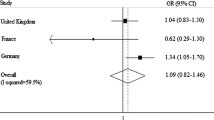Abstract
Objective: It has been suggested that parental occupation, particularly farming, increased the risk of Ewing's sarcoma in the offspring. In a national case–control study we examined the relationship between farm and other parental occupational exposures and the risk of cancer in the offspring. Methods: Cases were 106 persons with confirmed Ewing's sarcoma or peripheral primitive neuroectodermal tumor. Population-based controls (344) were selected randomly via telephone. Information was collected by interview (84% face-to-face). Results: We found an excess of case mothers who worked on farms at conception and/or pregnancy (odds ratio (OR) = 2.3, 95% confidence interval (CI) 0.5–12.0) and a slightly smaller excess of farming fathers; more case mothers usually worked as laborers, machine operators, or drivers (OR = 1.8, 95% CI 0.9–3.9). Risk doubled for those whose mothers handled pesticides and insecticides, or fathers who handled solvents and glues, and oils and greases. Further, more cases lived on farms (OR = 1.6, 95% CI 0.9–2.8). In the 0–20 years group, the risk doubled for those who ever lived on a farm (OR = 2.0, 95% CI 1.0–3.9), and more than tripled for those with farming fathers at conception and/or pregnancy (OR = 3.5, 95% CI 1.0–11.9). Conclusions: Our data support the general hypothesis of an association of Ewing's sarcoma family of tumors with farming, particularly at younger ages, who represent the bulk of cases, and are more likely to share etiologic factors.
Similar content being viewed by others
References
Horowitz M, DeLaney T, Malawer M, Tsokos M (1993) Ewing's sarcoma family of tumors: Ewing's sarcoma of bone and soft tissue and the peripheral primitive neuroectodermal tumors. In: Pizzo P, Poplack D, eds. Principles and Practice of Pediatric Oncology Philadelphia: JB Lippincott, pp. 795-821.
Parkin D, Kramarova E, Draper G, et al. (1998) International Incidence of Childhood Cancer, vol. II. Lyon: International Agency for Research on Cancer. IARC Scientific Publication No. 144.
Holly A, Aston D, Ahn D, Kristiansen J (1992) Ewing's bone sarcoma, paternal occupational exposure, and other factors. Am J Epidemiol 135: 122-129.
Winn D, Robison L, Mulvihill J, Daigle A, Fraumeni J (1992) A case-control study of the aetiology of Ewing's sarcoma. Cancer Epidemiol Biomarkers Prev 1: 525-532.
Hum L, Kreiger N, Finkelstein MM (1998) The relationship between parental occupation and bone cancer risk in the offspring. Int J Epidemiol 27: 766-771.
Buckley J, Pendergrass T, Buckley C, et al. (1998) Epidemiology of Osteosarcoma and Ewing's sarcoma in childhood. Cancer 83: 1440-1448. Ewing's sarcoma in Australia 269
Holman C, Reynolds P, Byrne M, Trotter J, Armstrong B (1983) Possible infectious aetiology of six cases of Ewing's sarcoma in Western Australia. Cancer 52: 1974-1976.
Zamora P, Paredes MD, Baron M, et al. (1986) Ewing's tumor in brothers: an unusual observation. Am J Clin Oncol 9: 358-360.
Valery P, Williams G, McWhirter W, Sleigh A, Scott D, Bain C (2000) Electronic telephone directory listings: preferred sampling frame for a population-based study of childhood cancer in Australia. Ann Epidemiol 10: 504-508.
SPSS i (1999) SPSS for Windows. Release 10.0.5 ed. Chicago: SPSS.
Miettenen OS (1976) Estimability and estimation in case-referent studies. Am J Epidemiol 103: 226-235.
Hoar S, Morrison A, Cole P, Silverman D (1980) An occupational and exposure linkage system for the study of occupational carcinogenesis. J Occup Med 22: 722-726.
ABS (1986) Australian Standard Classification of Occupations. Catalogue 1222.0, 1st edn. Canberra: Commonwealth of Australia.
Boyle C, Brann E (1992) Proxy respondents and the validity of occupational and other exposure data.AmJ Epidemiol 136: 712-721.
Rothman K, Greenland S (1998) Modern Epidemiology, 2nd edn. Philadelphia: Lippicott-Raven.
Teschke K, Smith J, Oshan A (2000) Evidence of recall bias in volunteered vs. prompted responses about occupational exposures. Am J Indust Med 38: 385-388.
Fabia J, Thuy T (1974) Occupation of father at time of birth of children dying of malignant diseases. Br J Prev Soc Med 28: 98-100.
Wilkins J, Sinks T (1990) Parental occupation and intracranial neoplasms of childhood: results of a case-control study. Am J Epidemiol 132: 275-292.
Wilkins J, Koutras R (1988) Paternal occupation and brain cancer in offspring: a mortality-based case-control study. Am J Indust Med 14: 299-318.
Sharpe C, Franco E, Camargo Bd, et al. (1995) Parental exposures to pesticides and risk of Wilm's tumor in Brazil. Am J Epidemiol 141: 210-217.
Kristensen P, Andersen A, Irgens L, Bye A, Sundheim L (1996) Cancer in offspring of parents engaged in agricultural activities in Norway: incidence and risk factors in the farm environment. Int J Cancer 65: 39-50.
Author information
Authors and Affiliations
Rights and permissions
About this article
Cite this article
Valery, P.C., McWhirter, W., Sleigh, A. et al. Farm exposures, parental occupation, and risk of Ewing's sarcoma in Australia: a national case–control study. Cancer Causes Control 13, 263–270 (2002). https://doi.org/10.1023/A:1015036109130
Issue Date:
DOI: https://doi.org/10.1023/A:1015036109130




